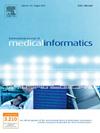Artificial intelligence generated visual communication improves comprehension and adherence in cervical cancer screening: a randomized controlled study
IF 4.1
2区 医学
Q2 COMPUTER SCIENCE, INFORMATION SYSTEMS
International Journal of Medical Informatics
Pub Date : 2025-10-09
DOI:10.1016/j.ijmedinf.2025.106134
引用次数: 0
Abstract
Background
Cervical cancer is preventable, yet poor comprehension of Pap smear results and non-adherence to follow-up major barriers, particularly in low health literacy settings. In Georgia, where screening coverage is below 20%, innovative communication strategies are needed. Artificial intelligence (AI) offers opportunities to strengthen patient communication through adaptive, emotionally expressive visual tools.
Objective
To evaluate whether AI-generated visual explanations, paired with simplified text, improve comprehension, satisfaction, and follow-up adherence after cervical cancer screening compared with conventional text reporting.
Methods
A randomized controlled trial enrolled 3,000 women aged 21–65 who underwent Pap smear testing between March and October 2024. Participants were randomized to three groups: Control (standard text), Text-only (enhanced plain-language text), and Intervention (AI-generated visuals plus text). Visuals were created with Craiyon, refined through expert and patient feedback, and aligned with Bethesda categories. Surveys assessed comprehension, satisfaction, and follow-up intent, while electronic records verified adherence. Analyses included chi-square tests, Kruskal-Wallis conformation for ordinal outcomes, and logistic regression for demographics and health literacy.
Results
The Intervention group achieved superior outcomes across all metrics. Comprehension reached 90 % versus 78 % in Text-only and 65 % in Control (χ2(2) = 131.8, p < 0.001). Satisfaction was 90 % in the Intervention group, compared with 78 % and 65 %. Follow-up adherence was 75 % with AI visuals, 65 % with Text-only, and 50 % with Control, corresponding to a threefold increase in odds of adherence (OR = 3.0; 95 % CI: 2.5–3.6; H(2) = 136.3, p < 0.001). Gains were most pronounced for abnormal results, including ASCUS, LSIL, and HSIL.
Conclusions
AI-generated visual communication significantly improved comprehension, satisfaction, and follow-up adherence in cervical cancer screening. This study demonstrates a scalable informatics solution for patient engagement, though challenges remain regarding long-term behavioral impact, cross-cultural adaptation, and integration into routine health information systems.
人工智能产生的视觉交流提高了宫颈癌筛查的理解和依从性:一项随机对照研究。
背景:宫颈癌是可以预防的,但对子宫颈抹片检查结果了解不足和不遵守随访是主要障碍,特别是在卫生素养低的环境中。在筛查覆盖率低于20%的格鲁吉亚,需要创新的传播战略。人工智能(AI)通过自适应的、情感表达的视觉工具提供了加强患者沟通的机会。目的:评价与传统文本报告相比,人工智能生成的视觉解释,结合简化的文本,是否能提高宫颈癌筛查后的理解、满意度和随访依从性。方法:一项随机对照试验招募了3000名年龄在21-65岁之间的女性,她们在2024年3月至10月期间接受了巴氏涂片检查。参与者被随机分为三组:对照组(标准文本)、纯文本(增强的纯语言文本)和干预组(人工智能生成的视觉效果加文本)。视觉效果是用Craiyon创建的,通过专家和患者的反馈进行改进,并与Bethesda类别保持一致。调查评估理解、满意度和随访意图,而电子记录验证依从性。分析包括卡方检验、有序结果的Kruskal-Wallis构象和人口统计学和健康素养的逻辑回归。结果:干预组在所有指标上均取得了较好的结果。结论:人工智能生成的视觉交流显著提高了宫颈癌筛查的理解程度、满意度和随访依从性。结论:人工智能生成的视觉交流显著提高了宫颈癌筛查的理解程度、满意度和随访依从性。本研究展示了一种可扩展的患者参与信息学解决方案,尽管在长期行为影响、跨文化适应和融入常规卫生信息系统方面仍存在挑战。
本文章由计算机程序翻译,如有差异,请以英文原文为准。
求助全文
约1分钟内获得全文
求助全文
来源期刊

International Journal of Medical Informatics
医学-计算机:信息系统
CiteScore
8.90
自引率
4.10%
发文量
217
审稿时长
42 days
期刊介绍:
International Journal of Medical Informatics provides an international medium for dissemination of original results and interpretative reviews concerning the field of medical informatics. The Journal emphasizes the evaluation of systems in healthcare settings.
The scope of journal covers:
Information systems, including national or international registration systems, hospital information systems, departmental and/or physician''s office systems, document handling systems, electronic medical record systems, standardization, systems integration etc.;
Computer-aided medical decision support systems using heuristic, algorithmic and/or statistical methods as exemplified in decision theory, protocol development, artificial intelligence, etc.
Educational computer based programs pertaining to medical informatics or medicine in general;
Organizational, economic, social, clinical impact, ethical and cost-benefit aspects of IT applications in health care.
 求助内容:
求助内容: 应助结果提醒方式:
应助结果提醒方式:


